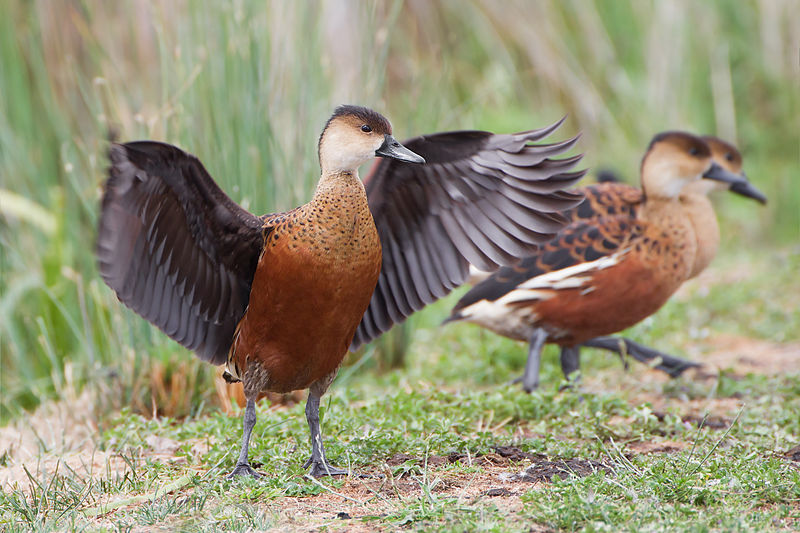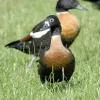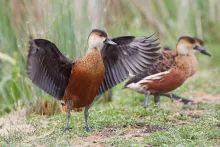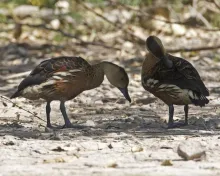
Wandering whistling duck (Dendrocygna arcuata australis)
Species name
- Dutch name:
- Wandering fluiteend
- English name:
- Wandering whistling duck
- German name:
- Wanderpfeifgans
- French name:
- Dendrocygne à lunules
- Scientific name:
- Dendrocygna arcuata australis
Scientific classification
- Order:
- Anseriformes
- Family:
- Anatidae
- Onderfamilie:
- Dendrocygninae
- Genus:
- Dendrocygna
Description
- Description:
Male:
With rich red-brown plumage overall, with a paler face, front of neck and upper breast. There is a dark stripe on the crown of head, nape and back of neck. The bill and legs are dark. There are elongated flank plumes, which are off-white with chestnut edges. In flight, the dark underwings, cinnamon and chestnut underbody, white undertail and trailing dark legs are seen.Female:
Similar to male. But sometimes with less elongated flank plumes.Juvenile:
Duller and lacking the broad pale feather edgings on the back ,so that mantle appears darker; underparts less chestnut and lacking some or all black spotting on sides of lower neck and upper chest. Chestnut on lesser wing-converts much reduced in extent and color, and entirely absent from median wing-converts. Bill, legs and feet paler grayish black.
- Behaviour:
Flocks are made up of pairs and their families. Sometime they 'adopt' stray Plumed whistling-duck (Dendrocygna eytoni) ducklings.
Strong, permanent pair bonds.
Standard Measurements
- Body Length (cm):
- The male (drake) of the Wandering whistling duck measures approximately 55-60 centimeters. The female measures approximately 52-58 centimeters.
- Body Weight (grams):
- The male will weight about 725-950 gram. The female will weight about 710-900 gram.
The weight is notoriously variable and can only be used as indication!
- Subspecies:
There is three subspecies:
- Dendrocygna arcuata arcuata - East Indian Wandering Whistling Duck
- Dendrocygna arcuata australis - Australian Wandering Whistling Duck
- Dendrocygna arcuata pygmaea - Lesser Wandering Whistling Duck
- Note:
Whistling-ducks generally do well, either in pens or in a park with access to extensive water area and good natural cover. They are gregarious outside the breeding season, and groups may bully smaller duck species, so should be kept in large areas, in which other birds have room to escape. Most need shelter in severe weather and a well-sheltered pen with frost-free night quarters for winter is suggested, or plenty of ground cover and/or straw to stand on, as they are susceptible to frostbite. They may be kept fully-flighted in aviaries, and have also been kept full-winged in open pens, tending not to wander. Perches should be provided at an appropriate height for pinioned or wing-clipped birds. Commercial pellets and grain are suitable for feeding.
Elevated nest boxes are appreciated by most species, although pinioned birds will use ground-level boxes; boxes may be placed over water or land. Eggs may be incubated by bantams and ducklings may be bantam-reared. Many species have been successfully parent-reared in captivity. Pairs kept isolated and fully flighted in a covered pen, with high-hung nest boxes "seldom fail to rear broods". Whistling-duck species may hybridise with one another and therefore should be kept in separate enclosures, and hybridisation has also occasionally been reported with Rosy-billed pochard (Netta peposaca).
This is one of the least hardy of the whistling-ducks. These ducks may be maintained in groups or in mixed collections. Enclosures containing a pond with substantial vegetation and a water depth of at least 1m are preferred, although they may also be kept in aviaries. A soft substrate such as grass is prefered and appropriate low, large-diameter perches should be provided. They may also easily be stressed by capture.
Breeding success has been very good in recent years in Australia. Wandering whistling ducks nest on the ground, under the protection of long grass or a bush, not necessarily near water; they also use hollow logs and ground-level or raised nest boxes. These ducks normally lay May to June. Use of overhead sprinklers (approximately one hour every other day) in combination with increased protein in the diet may stimulate breeding.
Ducklings may be parent reared (parents are very protective). Artificially reared ducklings should be kept in their own group - they tend to attack strange birds. The ducklings eat voraciously and care should be taken to provide sufficient food or the lowest-ranking ducklings may not get to eat; if necessary, obviously undersized birds should be removed and reared separately.
Artificial incubation and rearing may be used, although imprinting may occur if they are given much contact with humans in the first 4-6 hours after hatching. Broodies may also be used, and ducklings have been reared successfully by Plumed whistling-duck (Dendrocygna eytoni) and Maned duck (Chenonetta jubata).
Wandering whistling-ducks readily hybridise with Fulvous whistling-duck (Dendrocygna bicolor) and should be kept separate from that species; they have also been known to hybridise with Plumed whistling-duck (Dendrocygna eytoni).
- Breeding:
- The female Wandering whistling duck usually lays from 10-12 creamy white eggs and incubates them for 28-30 days.
- Artificial incubating:
The ideal relative humidity for incubating most waterfowl eggs is 55% (ground nesters) and 40% (cavity nesters). The temperature is usually 37.4°C. Set ventilation as recommended by the incubator manufacturer. Eggs must be turned, either automatically or by hand, a minimum of 4 times a day. As the duckling develops there is a loss of water from the egg and the air sac gets bigger. In normal development of an egg with a 28-30 days incubation, the air sac occupies about a third of it three days earlier. Cleanliness is vital and ideally eggs should be moved to a separate hatcher at this point, where the humidity should be increased to 65% and even higher once they have pipped internally.
- Bird banding:
- Recommended closed leg band ring size for the Wandering whistling duck is 12 mm.The leg band ring can only be applied on a young whistling duck at around 12-14 days old.
- It doesn't matter what leg that you band, but it's good to have a consistent system. Suggested: Left leg = Female, Right leg = Male
- Maintenance food:
-





Floating full food for all sea ducks, green ducks, eider ducks and geese, especially in the moulting and breeding phase ideally suited. Packed with wholesome raw materials, natural vitamins and trace elements, this performance food with a protein content of 30% forms the basis for lifelong vitality.




